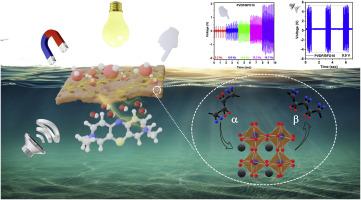Smart multi-stimuli responsive magneto-piezoelectric composite material based on PVDF and BiFeO3 nanoparticles for catalysis and energy harvesting
IF 4.1
2区 化学
Q2 POLYMER SCIENCE
引用次数: 0
Abstract
The development of hybrid magneto-piezoelectric composite materials with enhanced functional capabilities represents a relevant area of research. The integration of the functional properties of piezoactive nanomaterials and a ferroelectric polymer matrix creates novel solutions for applications in catalysis and electronics. This study proposes a new approach to creating two-phase polymer-inorganic composite films based on the piezoelectric polymer PVDF and the nanocrystalline multiferroic BiFeO3 (BFO). Phase inversion using a non-solvent and thermal treatment combined with doctor blade technology enabled the formation of PVDF/BFO composites with an 86 % electroactive phase content. The variation in BFO concentration led to changes in morphology, increased magnetization, and improved mechanical and electromagnetic energy conversion characteristics. Photocatalytic and piezocatalytic experiments demonstrated methylene blue (MB) degradation efficiencies of 97 % (photocatalysis) and 79 % (piezocatalysis) for PVDF/BFO5, and 95 % (photocatalysis) and 83 % (piezocatalysis) for PVDF/BFO10, with reaction rate constants of 0.048 min−1 and 0.035 min−1, respectively. The absence of synergistic enhancement in combined photo- and piezocatalysis was attributed to charge compensation at the interface. The degradation mechanism of MB was confirmed using radical scavenger experiments and density functional theory (DFT) calculations, identifying hydroxyl radicals (•OH) as the primary active species and elucidating key intermediate products, including hydroxylated and ring-opening derivatives. Mechanical energy harvesting characteristics were studied under various excitations applied to the piezoelectric nanogenerator (PENG), including rolling motion, compression, periodic vibrations, and ultrasonic (US) exposure. Under US, PENG tests revealed an increase in output voltage from 5.2 V (pure PVDF) to 7.6 V (PVDF/BFO5) and 9.9 V (PVDF/BFO10), corresponding to a 1.5–1.9-fold enhancement. Under vertical compression with a 4.4 N force, the peak output voltage of PVDF/BFO10 reached 24 V, with a corresponding power density of 12 μW/m2 at an optimal load resistance of 10 MΩ. The ability to convert parasitic magnetic fields through magneto-mechanoelectric coupling was confirmed. When placed near the power cable of an electric kettle (2200 W), the PENG device generated an induced voltage, demonstrating its capability to harvest stray electromagnetic energy. The reduced conversion efficiency of BFO10 compared to BFO5 under magnetic field exposure is attributed to decreased membrane elasticity at high nanoparticle loadings, leading to lower deformation and reduced electrical power output. These findings highlight the potential of PVDF/BFO composites for applications in energy harvesting and catalysis, paving the way for the development of smart multifunctional materials.


基于 PVDF 和 BiFeO3 纳米粒子的智能多刺激响应磁压电复合材料,用于催化和能量收集
本文章由计算机程序翻译,如有差异,请以英文原文为准。
求助全文
约1分钟内获得全文
求助全文
来源期刊

Polymer
化学-高分子科学
CiteScore
7.90
自引率
8.70%
发文量
959
审稿时长
32 days
期刊介绍:
Polymer is an interdisciplinary journal dedicated to publishing innovative and significant advances in Polymer Physics, Chemistry and Technology. We welcome submissions on polymer hybrids, nanocomposites, characterisation and self-assembly. Polymer also publishes work on the technological application of polymers in energy and optoelectronics.
The main scope is covered but not limited to the following core areas:
Polymer Materials
Nanocomposites and hybrid nanomaterials
Polymer blends, films, fibres, networks and porous materials
Physical Characterization
Characterisation, modelling and simulation* of molecular and materials properties in bulk, solution, and thin films
Polymer Engineering
Advanced multiscale processing methods
Polymer Synthesis, Modification and Self-assembly
Including designer polymer architectures, mechanisms and kinetics, and supramolecular polymerization
Technological Applications
Polymers for energy generation and storage
Polymer membranes for separation technology
Polymers for opto- and microelectronics.
 求助内容:
求助内容: 应助结果提醒方式:
应助结果提醒方式:


